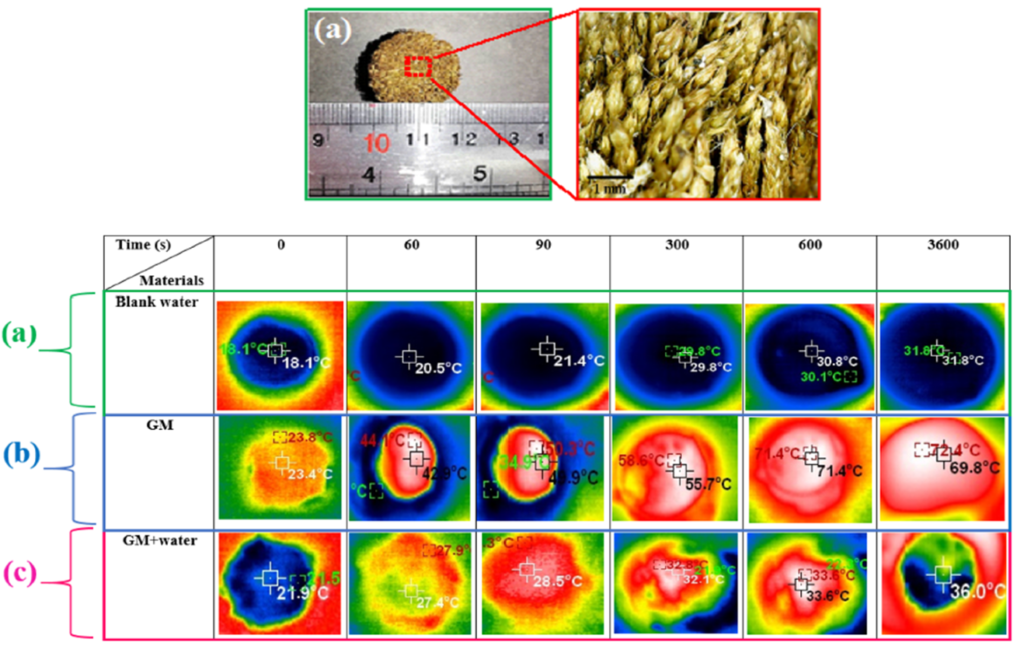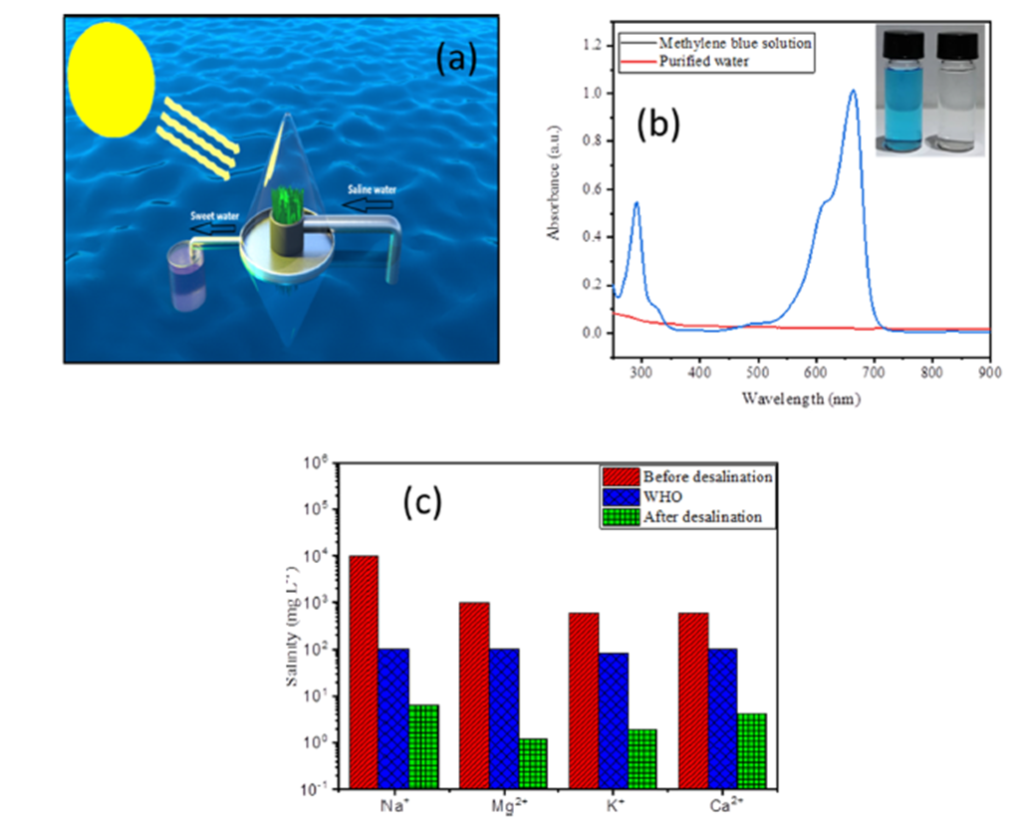Drinking water using green moss
Author: Daniel González-Muñoz is a predoctoral researcher in photocatalytic processes at Universidad Autónoma de Madrid.
We live on a planet that is commonly known as the blue planet. This is because more than 70% of its surface is covered by water. However, it is ironic that one of the biggest problems humanity will face in the coming decades is the scarcity of drinking water. Despite the large amount of water available on Earth, only 2.5% is fresh water. The remaining 97.5% is found in the oceans and saltwater seas. For this reason, the scientific community has invested great efforts in developing systems capable of desalinizing water to obtain drinking water. Solar vapour generation is an effective way to desalinate water, and solar evaporators should be economic, easy to manufacture, and efficient systems. Multiple types of nanoparticles have been used for solar steam generation, but biomass-based materials are of special interest due to their low cost and high abundance. It is important to highlight that a solar steam generator must have maximum absorption in the solar spectrum, ability to transform light-to-heat-to-vapour, and capability to supply adequate water to evaporation area. Green moss, belonging to the bryophytes, presents all these characteristics, and in this work they are used as solar steam generators to obtain drinking water [footmote]Masoud Khajevand, Saeid Azizian, Rabah Boukherroub (2021) Naturally Abundant Green Moss for Highly Efficient Solar Thermal Generation of Clean Water. ACS Appl. Mater. Interfaces. 13, 31680-31690. doi: 10.1021/acsami.1c06810.[/footnote].
As shown in figure 1 (top), green moss (GM) has elongated filaments of 0.5 mm in diameter. Furthermore, GM has superhydrophilic properties, which guarantees the supply of water for subsequent evaporation. To study the potential of GM as a solar steam generator, a thermal analysis with an infrared (IR) camera is used (Figure 1, bottom). When making a blank, irradiating a water sample under sunlight (1 sun = 1 kW m-2), it is observed that the temperature of the water surface increases up to 30ºC, and remains constant due to the evaporation process (Figure 1, bottom (a)). On the other hand, when exposing GM to 1 sun of irradiation (Figure 1, bottom (b)), it is observed that the temperature increases to more than 70ºC. This is due to the morphology of GM, which is capable of trapping sunlight and converting it into heat. When GM comes into contact with the surface of water (Figure 1, (c)), an increase in temperature up to approximately 35ºC is observed. This indicates that evaporation is effectively taking place on the GM surface, demonstrating the potential of GM as a solar steam generator.

The effectiveness of GM as a solar steam generator is shown in figure 2. To measure the capacity of GM in water evaporation, the mass change of water under different sunlight irradiation is measured. It is important to note that the mass change under 1 sun irradiation (2.61 kg m-2 h-1), which is four times the evaporation rate of blank water, is the highest result using modified biomasses as solar steam generator.
The authors’ hypothesis to explain this effectiveness of the GM as a solar steam generator is based on its morphology. GM presents a structure in the form of filaments with micro-grooves. This morphology causes water molecules to form bonds with the walls and weaken hydrogen bonds with other water molecules, which are in the form of clusters. These clusters easily transfer from the liquid to the vapour phase, increasing the evaporation rate. The micro-tube structure decreases the energy needed to pass water molecules from liquid to vapour phase.

To check the efficiency of GM under real conditions of irradiation and temperature, the mass change was studied on a sunny day between 8:00 h and 18:00 h (Figure 3). In any period of the day, it can be verified that the mass change is greater in the presence of GM. As expected, the mass change increases when the irradiation and temperature are higher throughout the day.
In addition, the influence of the system inclination on the efficiency as a solar steam generator was studied. A system was used in a horizontal position, and another that moved with the Sun up to an inclination of 35º. The results showed that the system in a horizontal position is sufficiently effective, since the tilted system only improved the mass change by ≈12%.

To demonstrate the effectiveness of GM in desalination (simulated seawater) and water purification, a solar-distillation system as shown in figure 4 (a) was used. Water purification was carried out by exposing GM to the sunlight in solution of methylene blue (0.8 mg L-1). After condensing the evaporated water, the UV-Vis absorption of the solution was measured. Figure 4 (b) shows that the characteristic absorption signals of methylene blue disappear in the condensed water. In addition, the inset image shows how the characteristic colour of methylene blue fades. To demonstrate the effectiveness of GM in desalination of simulated seawater, the concentration of four ions (Na+, Mg2+, K+, Ca2+) was measured before and after the evaporation process (Figure 4 (c)). In the four examples, ion concentrations values are lower than the minimum accepted by the World Health Organization (WHO).

In order to improve the values of mass change in GM, chemical modifications were carried out on the GM surface. The GM surface was functionalized with graphite oxide (GO-GM), gold nanoparticles (Au-GM), and a polymer (Ppy-GM). The mass change in the evaporation process was measured, as it is shown in Figure 5. An improvement in mass change was observed for all the functionalized GM. In order to compare the results with pristine GM (1 sun), 2.93, 3.07 and 3.25 kg m-2 h-1 mass change values were obtained for GO-GM, Au-GM and Ppy-GM, respectively. Despite the improvement in the results of mass change, from a practical point of view, it is more economic to use pristine GM.

This work shows that a worldwide problem, such as the lack of drinking water for some regions of the planet, can be combated using a natural system such as green moss. Its excellent properties mean that drinking water can be obtained with the simple combination of green moss, solar irradiation and seawater.